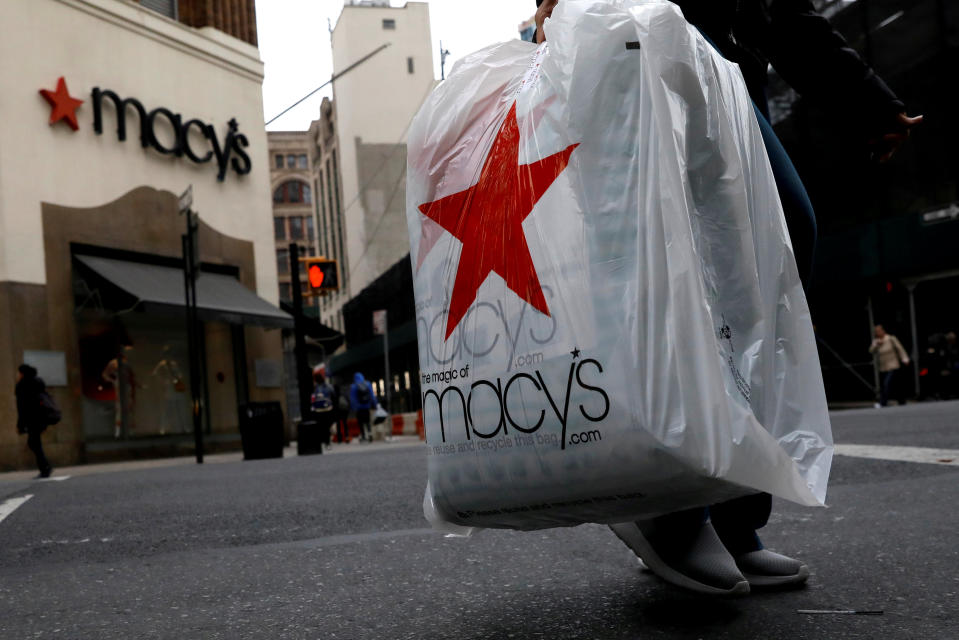Retail sales, Macy's earnings — What you need to know in markets on Wednesday
Stocks snapped a four-day losing streak on Tuesday as U.S. investor concerns over financial conditions in emerging markets finally abetted after weighing on investor concerns since late last week.
Each of the major U.S. indexes rose Tuesday, with the Nasdaq and S&P 500 both leading the way with a 0.6% advance while the small-cap Russell 2000 rose 1% to outperform the benchmark indexes.
On Wednesday, a busy week for the retail sector will bring investors the week’s biggest economic highlight with the July report on retail sales set to show a 0.1% increase over the prior month, according to estimates from Bloomberg. This is expected to mark a deceleration in retail sales from June’s 0.5% increase, though excluding auto sales expectations are for a 0.3% increase in sales during July.
Also on the economic calendar will be the NAHB’s homebuilder sentiment reading for August, the Federal Reserve’s July report on industrial production, and the New York Fed’s Empire State manufacturing reading for the month of August.
And on the earnings side, Macy’s (M) will report results as will S&P 500 members NetApp (NTAP) and Cisco (CSCO). Macy’s shares have more than doubled over the last year as the retail sector — beaten down through 2015 and 2016 — has staged a big comeback over that period.

Small business optimism at a 35-year high
Small business optimism is at its highest level since 1983.
In August, the National Federation of Independent Businesses reported that its small business optimism index registered a 107.9 reading, better than expected and the second-highest reading on record.
“In the small business sector of the economy, Main Street’s performance over the last 21 months is unprecedented based on reports for the past 45 years by hundreds of thousands of NFIB’s member firms,” the NFIB said in a release. Twenty-one months ago, Donald Trump was elected president.
In the report, small businesses continue to complain about hiring workers, with 23% of businesses identifying labor quality as its more important problem. Only in 1999 and 2000 did this register as a more pressing problem for small businesses, according to Bespoke Investment Group.
Bespoke added in a note to clients on Tuesday that, “While a shortage of skilled labor would typically lead to wage pressures, so far that hasn’t been much of a problem for small business as only 7% cited Cost of Labor as their biggest problem.
“Meanwhile, Taxes and Government Red Tape, which were the biggest problems in recent years, continue to be less and less of an issue.”
On the one hand, the persistent lack of quality labor identified by small business owners as their biggest issue augurs well for future wage increases. Last week, Capital Economics wrote in a note to clients that figures on job openings in June indicated that demand for labor continues to outpace the supply.
However, the firm noted online job advertising costs make listing a job cheaper than in the past, while the rate of firms hiring workers and the rate of quits are rising more modestly than overall job listings. Average hourly earnings also rose 2.7% over last year in July with this number not showing a marked acceleration over the last year.
This paints the picture of a labor market with more slack than previously thought, and overall job gains in recent months that have showed few signs of slowing after the torrid pace of hiring seen in 2014, ’15, and ’16 would back up this view.
The insistence from employers that labor is hard to find, then, is somewhat belied by wage data suggesting they are content not to pay up for better workers. And from this line of thinking, one wonders what the takeaway from small business optimism ought to be for markets beyond outlining a partisan view of economic policy.
“Although some panned any celebration of the 4.1 percent second quarter GDP growth, small business owners beg to disagree,” the NFIB wrote. “Owners have never been so optimistic for so long.”
—
Myles Udland is a writer at Yahoo Finance. Follow him on Twitter @MylesUdland

 Yahoo Finance
Yahoo Finance 
